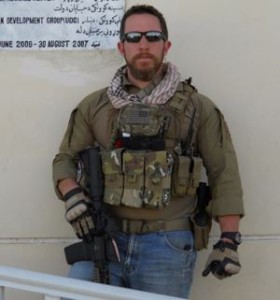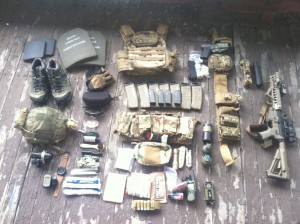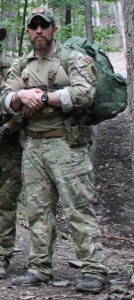Gear: My Operational Loadout: Chris
My Operational Loadout: by Chris:
As a follow up to my last write up on NODs, I want to talk about the load I have and would carry. What I have here is a bit of a hybrid of tried and tested gear in overseas operations as well as a couple things that I have added since being home.
There has been a major upsurge in tactical gear since GWOT with a lot of well-meaning vets developing kit that they wish they would have had when they were down range as well as major manufactures paying attention. Around the first Gulf War (’91), I remember US Cavalry catalogs pretty much limited to US general issue gear as well as NATO and Warsaw Pact kit.
Several deployments and a numerous modifications later, I have my current setup which I’ll break down and explain why I chose it.
No change to my helmet and NOD set up though I DO think I’ll get the CRYE nightcap for when helmets are too overt. Still, the lanyard to keep it around your neck for low pro operations with less kit and then a ballasted Ops Core helmet stay the same.
I have a banshee plate carrier in multicam as that is my chosen camo pattern. I’ve seen multicam work in numerous terrains, from MVT training ground to Afghan mountains. The plate carrier itself is clean of any main pouches but still retains a kangaroo pouch that can accommodate 3 AR mags. It has soft armor (level IIIa) in the front and back panels as well as cummerbund. I also have ESAPI plates and SAPI side plates that can be inserted based on the threat. I typically wore the side sapi’s on mounted operations when IEDs were a threat, but an up-gunner or open vehicle can also benefit from this when side protection may still be needed. Soft armor is great for most pistol and shotgun ammo as well as spall or richochet rounds that may come to rest against your kit after a near miss.
In addition to ballistic protection, I always have gloves and ballistic eye pro. Oakley is far in the lead as eye pro and a good gripped glove like Mechanix brand or similar work great.
Ear pro is huge though sometimes big peltor head sets can be a bit oversized. I included my surefire ear pro here as they work very well though I tend to talk to loud with them in as they aren’t electronic!
For load bearing I use the Mayflower UW chest rig. This thing was almost over designed it has so many features! It is made of very lightweight and durable materials, much stronger than condor nylon. What’s great about this vest is that it is configured in to clip onto the front of the plate carrier in seconds and secures to the cummerbund and I have a fully kitted plate carrier. I can also take the included harness which I keep in my ruck and can clip onto the rig and wear alone where armor may be a secondary necessity. In the chest rig I carry:
4 PMAGs, 2 glock mags, 1 Smoke grenade, two frag grenades, surefire flash light, multi-tool, weapon cleaning kit (lens brush, weapon brush, weapon cleaning tool, CLP, cleaning rag) , ear pro, gloves, map, write in the rain note pad, space blanket, extra set of batteries for all electronic devices, garmin fortrex, 6 chem sticks (colors/IR), M2000 IR strobe, gum, ranger bar, 5 hour energy drink, tourniquet, and a small bottle of water.
Fighting belt- I’ve stream lined this a bit. Max has a great design in the battle belt and I’ve made a version that is more urban/mounted operations savvy. I use it as something that will always allow me to conduct some kind of operation, even if I don’t have a kitted out vest. On it I carry 2 Pmags, 2 pistol mags, a CRKT knife, SMALL medical kit (tourniquet, surgical gloves, Israeli bandage and quick clot), pistol holster, dump pouch and a radio pouch. I can run ad ear bud through my clothes or plate carrier so that the push to talk is accessible around my chest or in my sleeve (for low pro).
I own several different rifles. If I am conducting night operations I ensure that I have a DBAL IR laser, weapon light (Inforce WML, GREAT light! Has numerous settings including strobe and IR and super lite!) and an AAC SDN multi caliber suppressor (stamped and legal BTW!!!) that can accommodate both my AR platforms as well as my M1A SOCOM 16. I have a mixture of optics though I lean towards ACOGs as they never run out of batteries (SHTF plus!)
Max covers very effectively (on the Combat Patrol Class) what to pack in to what kind of bag, weather it’s a rucksack for longer patrols or a 3 days assault pack. I really have nothing to add to his presentation and it works perfectly with my kit as well. Extra ammo, water, food and basic necessities for RON operations keep me at about 65-70 pounds of super light weight gear! What I want as a takeaway from this keeping your gear close to your body, and somewhat simple. I’ve seen several students come out to train with some seriously over loaded rigs with pouches that I think they hang just because they have them. Thing about minimizing! The students that come on the 5 day course will alter their gear as they go and notice how it gets less and less.
Enough ammo to survive a firefight, more or less depending on mission. Keep this ammo in your ‘work space’. I don’t particularly like carrying ammo that I can’t reach in a firefight, that constitutes extra weight. First aid kits within reach of either arm, tourniquet at the very least. Your arm may be shot, pinned or frickin’ gone so you may need to access it another way and self administer aid as your team fights up to you in the ambush you got caught in.
A thousand calories of food; cliff bars, protein bars, Gatorade pouches that runners use (Arnold Giz as we called it in the army) that can get you through one day of evasion and back to your team or supplies. A water bottle is great and can be refilled but a lifestraw can cut down on your liters of water you have carry with you. Plan accordingly, look at a map and find the water sources where you’re going to get this from. Look at weather reports and know your terrain/ area of operations for where water might be found. Morale is huge too. If you need some gum or a can of Copenhagen to keep your sprits up, pack it. Be wary of heavily scented stuff that may compromise your location. While many OPFOR have gone very techno savvy, tracking dogs or simply native people will know a smell that’s off.
I understand that a lot of you don’t have the funds of the trial and error ability to buy something and not like it and buy something else. Some of you have a significant other that’s going to cap your spending on kit. Hopefully some of these pointers will help you get a better idea of what to build and I’ll be sure to back up what I am saying wear this gear at MVT!
Chris
Input from Max: Chris has a great set up which is versatile. His mayflower chest rig with plate carrier is the same concept that I talk about with the TAP in THIS POST on gear options. Ballistic plates are important when we are taking about kinetic operations and you should plan to include them in your loadout in a way that you will actually wear them. Which brings us nicely back to PT. Funny that!
The lightweight battle belt is a great concept and I have one myself. The full battle belt is great for dismounted operations and if your SHTF survival plan does not include extensive use of vehicles then it’s a good one. The lighweight battle belt is also something that you may be more likely to wear around the retreat because it is more convenient. You can have both set up and pick as per the mission.
I have one of those Mayflower UW rigs on order as per Chris’s recommendation and seeing it used on the Combat Patrol class. I was initially put of because although it is far better than the issue TAP that I have, it has a limited magazine capacity at 4. That gives me the chills. It’s just a paranoia I have. However, with the pouch on the plate carrier behind, you can get a total of 7 in there, plus the 2 on a light weight battle belt and the 1 in the rifle makes 10. Now I feel better. Plus, as I have mentioned before, you are going to be wearing a patrol/assault pack of some sort/size, and this is where your second line scales of ammo resides, to resupply your mag pouches in a pause in the fight.
I like the idea, as per the TAP, of chest rigs that can either be worn on their own or snapped onto the front of your plate carrier. That gives a lot of versatility for different types of operations and profiles that you may run. With just the lightweight battle belt and the plate carrier, you have 5 mags plus one on your weapon. And that is if you keep it to 2 mags on the battle belt. You do have to resist overloading!
Oh yes: do more PT!




